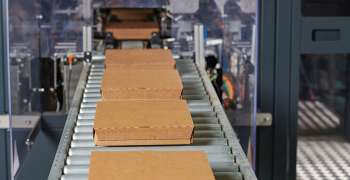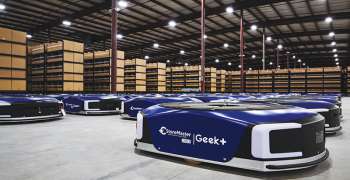CEVA CFO offers up take on global logistics market
Latest Material Handling News
When assessing the economic recovery, it is hard not to see that there are still many bumps in the road on the way to sustained growth. But even so, there are enough things happening that can make even the biggest naysayer somewhat optimistic. There was no shortage of optimism earlier this week when Logistics Management Group News Editor Jeff Berman had an opportunity to speak with Rubin McDougall, CFO of global 3PL CEVA, following the company’s strong fourth quarter and year-end earnings release.
CEVA’s 2010 revenue of roughly $9.4 billion (U.S.) was driven by what CEO John Pattullo said was a relentless focus on business basics and a series of transformational projects, coupled with a well-defined operating model, a clear plan for future growth, with strong momentum early in 2011. This was evident by CEVA’s strong global presence, with exceptional results in the Asia Pacific and Americas regions, as well as what the company said was a robust performance in its automotive, contract logistics, and freight management groups.
Below is a transcript of a conversation between CEVA’s McDougall and LM’s Berman about the company’s earning performance and the global logistics marketplace.
LM: In CEVA’s earnings statement, the company mentioned that its performance is back to pre-recession levels. What drove that in your opinion?
McDougall: There are several different things going on globally? One trend that is going strong is our intra-Asia business, which is going well. In the past, it was always Asia outbound to either Europe or the Americas and now the intra-Asia business is doing very well. That said, Asia outbound in the Americas continues to do very well, too, and that has been rebounding and is back. The recent growth rate—in the past few weeks—is off, but the base level business is good, whereas the Asia to Europe market has been very soft, particularly to southern Europe. As we look at European economies, there is a marked difference between north and south. North Europe is not as strong as the Americas, but it is still doing well.
LM: What are some of the biggest drags on the economy in southern Europe?
McDougall: Those economies if you look at freight movement, say, compared to Germany, do not have the export base and have made themselves not quite as attractive for importers. A good majority of freight has to come into that region over land.
LM: CEVA’s presence is widespread among many modes and forwarding areas. What mode do you think has seen the biggest rebound and which one is currently in the best position for growth over the next 12-to-18 months?
McDougall: The ocean business was tremendous as we moved through mid-2010. It started in the fourth quarter of 2009 and just boomed all the way through mid-2010. It seemed like it peaked earlier in the year compared to a normal year. It has been doing well since last August, but it is nowhere near what we usually see for peak levels in October and November, and it has softened as we entered 2011. Air cargo was a bit different mix. It was tremendous in 2010, particularly in the second half. Part of that, in my view, is biased by the industries we cover and have exposure to. But the amount of product launches in the technology sector happening kept the air business booming.
LM: Early on in 2010 through just about mid-year, there was a lot inventory re-stocking occurring, which helped to drive freight volumes promising signals and increased faith in the economic recovery. A year later, do you think things on more of a “normal” growth rate, whereas what happened with the inventory re-stocking last year was an exception?
McDougall: I do and I think we are back to a good level. My view is that for the full-year ocean will grow but grow more modestly.
LM: What is your take on the current run-up in oil and gas prices and how it impacts freight transportation and logistics? Are there any lessons learned from what we experienced in 2008, when prices hit record levels?
McDougall: If you think about fuel as it relates to the price of moving freight, it does have an impact. For outbound freight from Asia, the fuel surcharge is about 15 percent of the total freight bill. If that fuel surcharge doubles, it does not double the size of freight. But it does have that magnitude for air freight. On ocean, bunker fuel rates play a large part, but it does move around the rates a lot. In terms of lessons learned from 2008, there are some modal shifts occurring, which have shippers making decisions they would not have otherwise made. We are seeing some of that today as the need for capacity growth is no longer as stark as it was. And we are seeing shippers who are saying ‘given where we are today, I have a little more capacity and am not under as much stress as before. Maybe I can put some freight on ocean liners as opposed to expedited air.’ We are seeing modal shifts and are likely to continue to see them. It is something that did not happen as much in late 2010, because they were under deadlines and had to keep production moving and to rely on expedited freight movements. Today there is more leeway to shift modes and switch shipping lanes. That is another alternative that shippers are considering for inter-global shipments for things like outbound to Asia for example and not be as constrained by capacity limits.
LM: In light of this situation, what is CEVA’s overall stance on the sustainable supply chain, in terms of being environmentally conscious and responsible?
McDougall: To date, we do not receive an RFQ where folks don’t ask that question. That said, in many questions it feels like we are ahead of some of our customers on that front. As an example, we are installing green warehouses in different areas to take advantage of different incentives that were available. Some had solar panels, which serve as energy generators. And it also has to do with energy usage in warehouses, lighting and how lights are turned on and off efficiently, among other things. On the freight management side—in terms of energy savings—we have found that while people ask about sustainability it has not been taken as seriously as it should. But we are starting to see with oil prices up, that people are taking it more seriously, especially from a costs perspective. When the economy sank and gas prices were low, many people’s focus on being green slid somewhat. The higher price of oil brings the issue back front and center.
LM: Let’s talk about the trucking market. In different parts of the U.S., there is a heavy emphasis on regional movements for LTL and truckload. What is your take on the North American trucking market for things like fuel and capacity?
McDougall: There are lots of capacity-related regulations and concerns out there for things like HOS and CSA and how that might influence capacity over time. It does not feel like those things have had a huge impact at this point. It is there and a concern though. These things may have had some impact on margins for carriers but not as much for volumes.

Article Topics
News & Resources
Latest in Materials Handling
Registration open for Pack Expo International 2024 Walmart chooses Swisslog AS/RS and software for third milk processing facility NetLogistik partners with Vuzix subsidiary Moviynt to offer mobility solutions for warehouses Materials Handling Robotics: The new world of heterogeneous robotic integration BSLBATT is looking for new distributors and resellers worldwide Lucas Watson appointed CSO for Körber’s Parcel Logistics business in North America Hyster recognizes Dealers of Distinction for 2023 More Materials HandlingAbout the Author
Subscribe to Materials Handling Magazine

Find out what the world's most innovative companies are doing to improve productivity in their plants and distribution centers.
Start your FREE subscription today.
April 2024 Modern Materials Handling

Latest Resources










